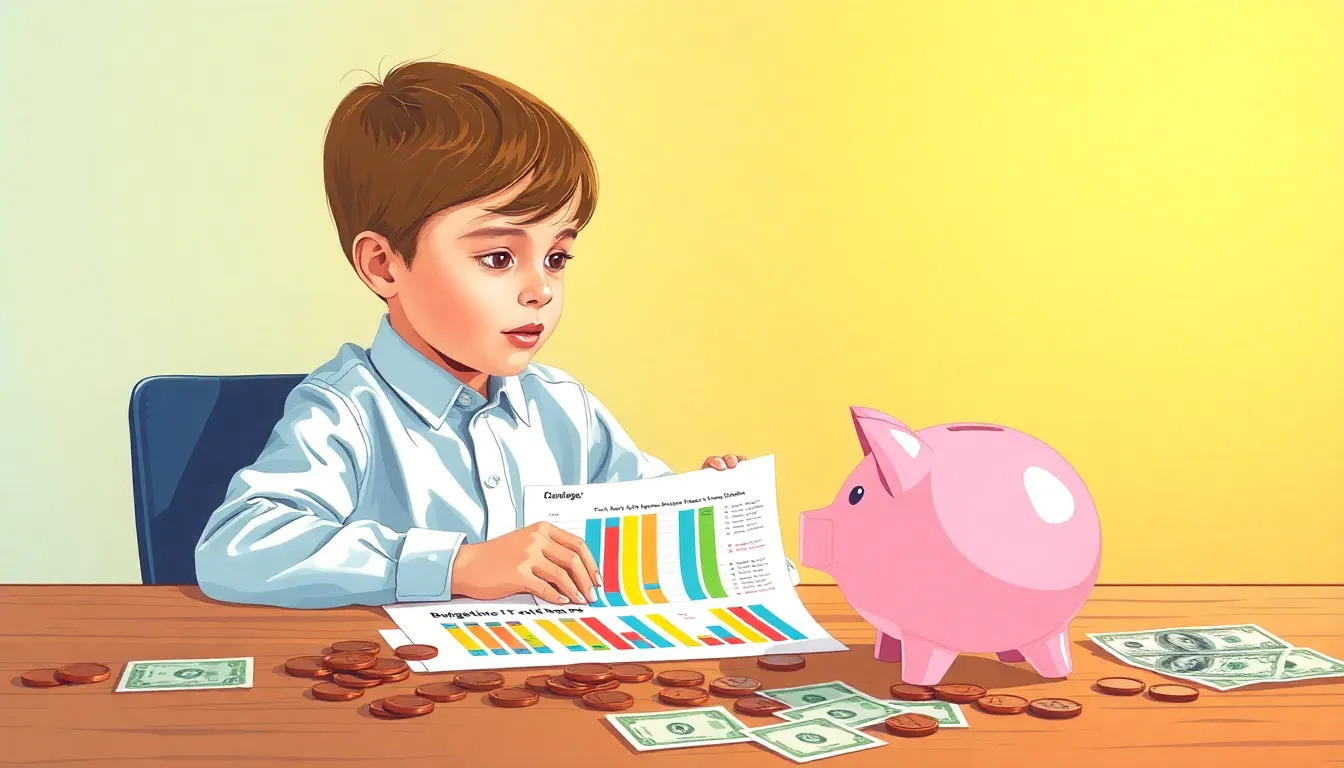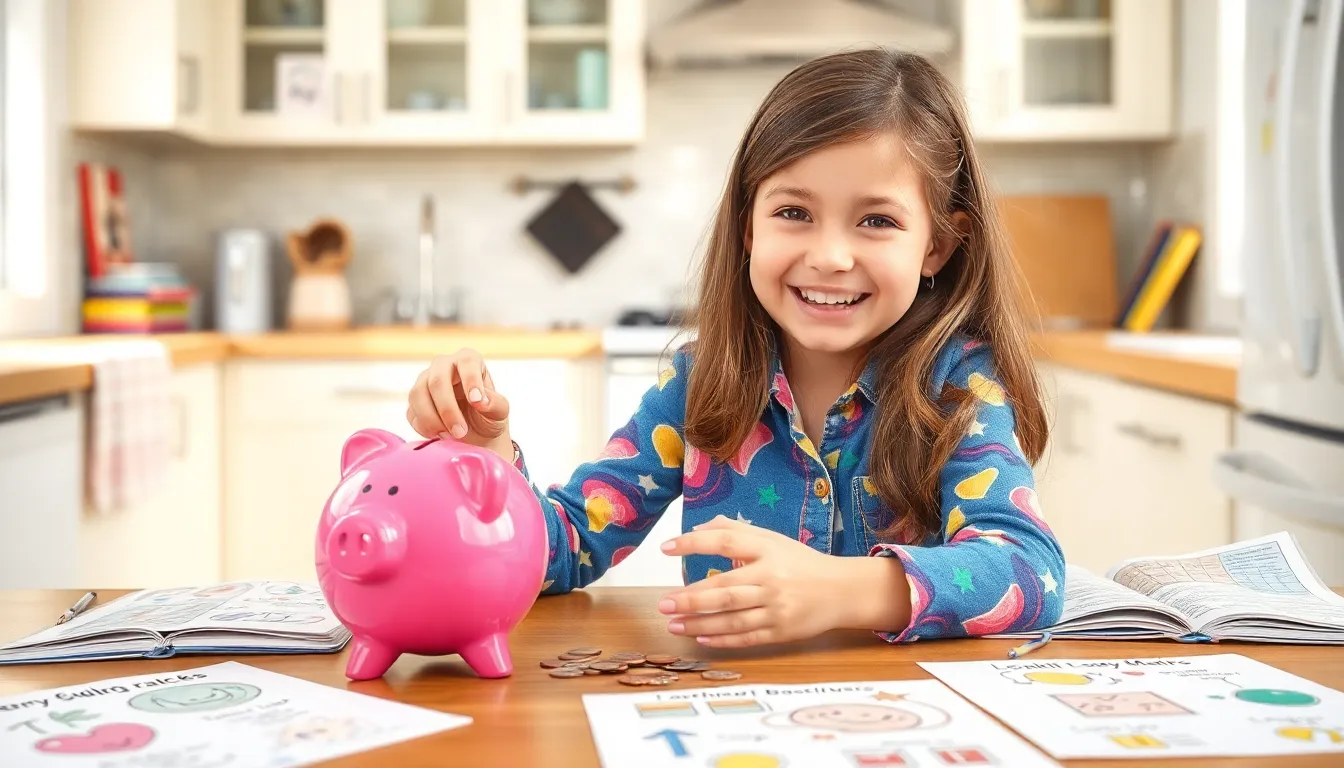Table of Contents
ToggleTeaching kids about budgeting isn’t just a financial lesson; it’s like giving them a superhero cape for their future. Imagine a world where your child knows the difference between needs and wants, and can navigate the money maze without a meltdown. Sounds dreamy, right? It’s time to turn those piggy banks into treasure chests of knowledge.
Understanding Budgeting For Kids
Budgeting fosters essential financial skills in children. Teaching kids the difference between needs and wants sets a solid foundation for responsible spending. Basic concepts such as saving, spending, and sharing should form the core of financial education. Activities like setting goals and maintaining a budget encourage proactive financial management.
Using tools like piggy banks can make the learning process engaging. They can visualize their savings and develop a habit of saving over time. Tracking spending helps children understand where their money goes. Parents can guide kids in listing expenses and categorizing them as necessary or discretionary.
Real-life scenarios enhance understanding. Role-playing can simulate shopping experiences, allowing children to make choices and feel the impact of their decisions. Games that incorporate budgeting principles can introduce fun while imparting knowledge.
Encouraging children to save for specific goals builds motivation. Parents can assist by creating a goal-oriented savings plan, reinforcing the importance of patience and foresight. Involving children in family budgeting discussions offers insights into adult financial responsibilities.
Resources and tools like mobile apps can make budgeting accessible. Age-appropriate apps gamify the budgeting process, making it captivating for kids. These digital resources provide visibility and allow for real-time tracking of financial goals.
Ultimately, budgeting prepares children for financial independence. Equipping them with lifelong skills establishes confidence in managing money effectively.
Importance Of Teaching Budgeting Early

Teaching budgeting early provides children the tools to make informed financial choices. Understanding how to manage money leads to greater financial stability.
Benefits Of Financial Literacy
Financial literacy benefits children by enhancing their ability to manage money. It equips them with the skills to set financial goals, understand the difference between needs and wants, and develop a sense of responsibility. Having financial knowledge prepares them to make sound decisions, preventing debt and impulsive spending. Engaging with budgeting also opens the door to discussions about credit, savings, and investments, promoting smart long-term planning. Programs in schools and age-appropriate resources further emphasize the importance of financial literacy, instilling confidence that benefits them throughout life.
Building Good Habits
Building good habits around budgeting starts with practical, hands-on experience. When children actively participate in setting budgets, they learn the importance of saving, spending wisely, and tracking expenses. Weekly allowances or monthly challenges can reinforce these lessons, encouraging them to prioritize their wants. Creating a chart or using apps helps visualize their progress toward savings goals, making learning more engaging. Additionally, consistent discussions about money management within the family foster an environment that values financial responsibility. As they encounter real-life situations, such as handling money for outings, they practice making choices informed by their budgeting skills.
Key Concepts In Budgeting
Teaching kids about budgeting involves grasping fundamental concepts like income and expenses. Understanding these key components lays the groundwork for effective financial management.
Income Sources For Kids
Kids often earn money through chores, allowances, or small jobs. Parents can encourage them to explore creative income opportunities like lemonade stands or lawn mowing. Each income source teaches children the value of hard work. Reinforcing savings habits from these earnings establishes a strong financial foundation. Setting goals for how to use earned money helps children prioritize their spending and saving effectively.
Expense Tracking
Kids benefit from tracking their expenses regularly. Writing down purchases helps them visualize where their money goes. Using simple tools like charts or journals encourages responsible spending. Parents can demonstrate how to categorize expenses into needs and wants. Review sessions can guide children in reassessing their spending habits. Tracking reinforces awareness of financial choices, making budgeting more engaging and educational.
Fun Ways To Teach Budgeting For Kids
Teaching kids budgeting can feel fun with interactive methods. Engaging games and activities make financial concepts relatable and exciting.
Games And Activities
Budgeting games provide hands-on experiences. Children can play board games that simulate financial choices and money management. Allowance challenges encourage them to save for a specific goal while managing their spending. Online apps like greenlight or piggybot gamify saving and tracking expenses, making these concepts vibrant and dynamic. Crafting DIY budgeting boards fosters creativity and visual learning. Parents can incorporate competitions where kids earn points for smart budgeting choices, reinforcing positive habits. Rewarding milestones, such as reaching savings goals, motivates children to continue practicing responsible financial behaviors.
Real-Life Scenarios
Real-life scenarios deepen understanding. Parents can involve children in planning family outings or shopping trips, allowing kids to experience budgeting firsthand. Assigning small shopping duties helps them manage a budget, prioritize needs, and make thoughtful purchasing decisions. Discussing monthly household expenses opens up conversations about costs, reinforcing practical budgeting skills. By participating in cost comparisons or sales discussions, kids learn to spot good deals while adhering to a budget. Regular discussions about money management help remove the mystery around finances, making budgeting a natural part of everyday life. Through these practical experiences, children gain confidence in their financial decision-making abilities.
Tools And Resources For Parents
Parents can leverage various tools and resources to teach budgeting skills effectively. Utilizing these resources makes the learning process engaging and accessible for children.
Budgeting Apps For Kids
Several budgeting apps cater specifically to children. Apps like Greenlight and PiggyBot gamify budgeting by allowing kids to set savings goals and track expenses. These platforms foster financial literacy through interactive features. Children can manage their allowances and earn rewards for reaching savings milestones. Parent controls in some apps enable guardians to oversee spending, ensuring safety. Each app provides colorful interfaces that attract kids while teaching essential financial concepts. They support independent learning and encourage kids to develop responsible financial habits early.
Printable Budget Templates
Printable budget templates serve as practical tools for children learning to budget. Parents can guide kids in creating their own templates that capture income, expenses, and savings goals. Various designs cater to different age groups, making budgeting relatable and fun. Simple templates include sections for needs and wants, helping kids distinguish between priorities. Using colorful charts can enhance visual engagement, turning budgeting into a creative activity. Regularly updating these templates fosters consistent financial tracking and responsibility. Templates encourage children to take ownership of their budgeting process, enhancing learning outcomes.
Teaching kids about budgeting is a vital step toward financial independence. By instilling these skills early on, children can navigate their financial futures with confidence. Engaging them in practical activities and discussions makes the learning process enjoyable and effective.
Utilizing tools like budgeting apps and printable templates further enhances their understanding. These resources allow kids to visualize their financial habits and set achievable goals. With consistent support from parents, children can develop a healthy relationship with money, ensuring they’re well-prepared for the challenges ahead. Building these habits now will serve them well throughout their lives.




